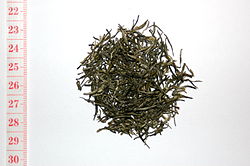- Mao Jian tea
-
Maojian 
Type: Green Other names: Chinese: 毛尖; , Green Tip or Tippy Green Origin: Henan Province, China Quick description: ???
Xin Yang Mao Jian tea (simplified Chinese: 信阳毛尖; traditional Chinese: 信陽毛尖; pinyin: Xìnyángmáojiān) is a green tea produced in Xinyang, Henan. It is designated as a China Famous Tea.Xin Yang Mao Jian is one type of green tea that originally was produced in northern China. The name can be divided into two parts that are associated with two aspects: "Xin Yang", the first part, is the place in China that produces this type of tea. "Mao Jian" are the words to depict the shape of the leaves. Throughout two thousand years of history, Xin Yang Mao Jian has been considered one of the ten top teas in China. It has a wide market and popularity in Henan province, where people like to drink it as a relaxing beverage after a busy day.
Located in southern Henan Province, Xin Yang is a place with a mild climate and good conditions for growing trees that produce the tea's unique quality: Xin Yang tea trees are planted at high altitudes where the weather is clearly divided by four distinct seasons. Many high mountains, such as Mt. Cheyun, Mt. Jiyun, and Mt. Tianyun, also surround the location in order to support environmental humidification and moisture. Moreover, there is an abundance of forests, clouds, rainfall, and a large temperature difference between day and night. These geographical advantages help keep Xin Yang's soil healthy and fertile, while trees more efficiently absorb chemical elements to produce higher quality green tea.
The appearance of the Mao Jian tea's leaves are commonly known as "hairy tips”, a name that refers to the leaves' slightly dark-green color, straight and delicate edges, and thin and firmly rolled appearance with both ends in a pointed shape[1]. The regular length of a Xin Yang Mao Jian tealeaf is about 0.5–1 inches. It also tends to form balls, releasing a rather pungent smell when stored for a long time. It needs air, or the lack of oxygen will release an odor, to make up for the lack of oxygen. Comparing it with other famous types of green tea, Mao Jian leaves are relatively small. After brewing Mao Jiang and pouring the water into a teacup, the aroma will flow into the air and create a peaceful atmosphere.
The harvest season for Mao Jian tea is in spring and fall. However the best quality tea comes from leaves that are harvested in mid-April. Chinese call it "Yu Qian Tea", which means the tea is picked earlier in the spring before the lunar term 'Rain'. Because the leaves are rare and fresh, the price will be two or three times higher than tea produced after this part of the season. In general, the approximate ratio of fresh leaves to produced tea is 50,000 buds: 500 grams.
Dating back to ancient Chinese history, tea production was initially developed during the Zhou dynasty (ca. 1066–221 BCE). The tea technique was originally invented in southern China, which then spread over the entire country with political and economic growth, as well as improvements in cultural interaction, transportation, and communication. Drinking tea gradually became more widely accessible, although also a symbol of class division in China. In Chen Yuan’s book History of Tea, the author explains, "Tea culture followed transportation movements settled in Henan's Qinling Mountain. Because of weather conditions, trees could no longer be pushed northward." In 1987, archaeologists in the Xin Yang area discovered ancient tea in excavated tomb sites, and determined that the tea was made in 875 BCE.
The tea industry has taken off even more in the twentieth-century, and Xin Yang Mao Jian has continued to build up its own unique style and frame. The late Qing dynasty scholar Hanlin Chen and others influenced a number of urban and rural areas, including Xinyang gentlemen, landlords, and merchants. One after another, different groups and communities began to develop their own tea production. They went to Hangzhou, Zhejiang and other important tea places to buy seeds, and learned the West Lake Longjing frying techniques. Based on knowing production technology, as well as knowledge about digestion and absorption, people in Xin Yang eventually improved their techniques and created a unique tea-frying process. In 1913, they produced "The Mountain Tippy" tea, later renamed "Xin Yang Mao Jian." Xin Yang Mao Jian won a gold medal in the Panama Pacific International Exposition, San Francisco, in 1914 and was selected for the top ten in 1958 [3].
References
Tea Black tea Oolong tea - Bai Ji Guan
- Red Robe
- Darjeeling Oolong
- Dongding (Tung-ting)
- Dong Fang Mei Ren
- Huangjin Gui (Golden Osmanthus)
- Qilan tea
- Pouchong
- Rou Gui
- Shui Jin Gui
- Shui Hsien (Shui Xian)
- Tie Luohan
- Tieguanyin (Iron Goddess)
Green tea - Aracha
- Bancha
- Green Spiral
- Chun Mee
- Da Fang
- Genmaicha
- Liuan Leaf
- Gunpowder
- Gyokuro
- Hojicha
- Hou Kui
- Huang Shan Mao Feng
- Hyson
- Kabusecha
- Kamairicha
- Konacha
- Kukicha
- Longjing (Dragon Well)
- Matcha
- Mao Jian
- Mecha
- Meng Ding Gan Lu
- Sencha
- Shincha
- Tamaryokucha
White tea Yellow tea Post-fermented tea Blended and
flavoured teasTea culture Tea beverages Other - Camellia sinensis (tea plant)
- Tea bag
- Teapot
- Consumption
- Flowering tea
- Glass-holder
- Health effects
- Tea processing
- Samovar
- Tea brick
- Tea garden
- Tea house
- Tea tasting
- Teakettle
See also Categories:- China famous tea
- Chinese tea grown in Henan
- Green tea
Wikimedia Foundation. 2010.

